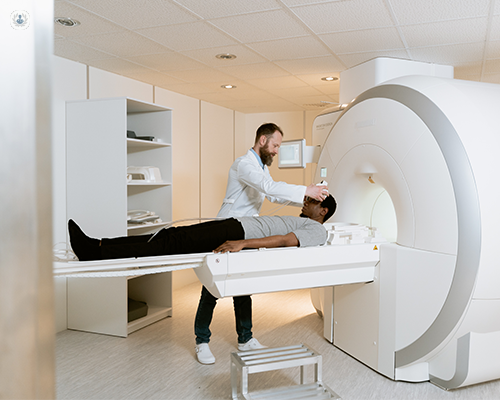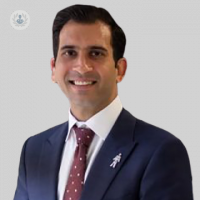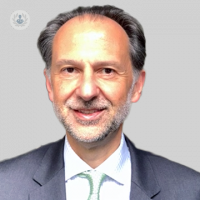What is HIFU (high-intensity focused ultrasound)?
High-intensity focused ultrasound or HIFU is a medical procedure which involves using high temperature, ultrasonic waves to remove problematic portions of bodily tissue. The cheap cost of HIFU compared to other alternatives, combined with its typically non-invasive nature, have led to increased testing, particularly in the past five years.

Why is HIFU carried out?
As with other forms of therapeutic ultrasound, there are a wide range of uses for HIFU. In a growing number of countries it is being used to treat neuropathic pain and Parkinson’s disease. It's suitability for treating other neurological disorders is still being evaluated.
Due to its effectiveness in burning away unwanted or damaged body tissue, HIFU is also used effectively as part of prostate, liver, kidney and breast cancer treatments as well as removal of fibroids. Additionally, HIFU is also used in both occupational therapy and physiotherapy.
What does HIFU involve?
This procedure consists of ultrasound beams at a temperature of up to 85 °C being directed at unwanted bits of tissue in order to incinerate and subsequently eliminate it. The ultrasonic beams produced only focus on a small area of tissue, which means surgeons will sometimes use multiple beams in order to remove all undesired tissue. Due to the delicate nature of HIFU therapy, image guidance is required both before and during the procedure. CT and MRI are typically used beforehand, while MRI and medical ultrasound have been regularly used during.
What are the risks?
The main risk of HIFU is healthy tissue surrounding the targeted area being accidently lacerated. However, thanks to the aforementioned monitoring techniques used both before and during surgery, such occurrences are rare. In addition, some parts of the body a more vulnerable than others and therefore are considered riskier for this kind of procedure.
04-28-2021 12-05-2023HIFU (high-intensity focused ultrasound)
What is HIFU (high-intensity focused ultrasound)?
High-intensity focused ultrasound or HIFU is a medical procedure which involves using high temperature, ultrasonic waves to remove problematic portions of bodily tissue. The cheap cost of HIFU compared to other alternatives, combined with its typically non-invasive nature, have led to increased testing, particularly in the past five years.

Why is HIFU carried out?
As with other forms of therapeutic ultrasound, there are a wide range of uses for HIFU. In a growing number of countries it is being used to treat neuropathic pain and Parkinson’s disease. It's suitability for treating other neurological disorders is still being evaluated.
Due to its effectiveness in burning away unwanted or damaged body tissue, HIFU is also used effectively as part of prostate, liver, kidney and breast cancer treatments as well as removal of fibroids. Additionally, HIFU is also used in both occupational therapy and physiotherapy.
What does HIFU involve?
This procedure consists of ultrasound beams at a temperature of up to 85 °C being directed at unwanted bits of tissue in order to incinerate and subsequently eliminate it. The ultrasonic beams produced only focus on a small area of tissue, which means surgeons will sometimes use multiple beams in order to remove all undesired tissue. Due to the delicate nature of HIFU therapy, image guidance is required both before and during the procedure. CT and MRI are typically used beforehand, while MRI and medical ultrasound have been regularly used during.
What are the risks?
The main risk of HIFU is healthy tissue surrounding the targeted area being accidently lacerated. However, thanks to the aforementioned monitoring techniques used both before and during surgery, such occurrences are rare. In addition, some parts of the body a more vulnerable than others and therefore are considered riskier for this kind of procedure.


Revolutionising treatment: The power and potential of high-intensity focused ultrasound (HIFU)
By Mr Marc Laniado
2024-11-19
High-intensity focused ultrasound (HIFU) is an innovative and non-invasive medical technology that has revolutionised the treatment of various conditions, particularly in cancer care. HIFU harnesses the power of sound waves to target and destroy diseased tissue, offering patients a treatment option that minimises recovery time, reduces side effects, and avoids invasive surgery. This article explores the power and potential of HIFU, focusing on its applications, benefits, and how it works. See more


Diagnosis and treatment: How is prostate cancer usually detected?
By Mr Zeb Khan
2024-11-09
Highly respected consultant urological surgeon Mr Zeb Khan sheds expert insight on the diagnosis and treatment of prostate cancer in this detailed article. See more


Treatment and monitoring of patients with prostate cancer: Expert insight on current approaches
By Mr Vivek Wadhwa
2024-10-26
After receiving a diagnosis of prostate cancer, patients require careful monitoring through PSA testing, even following successful treatment, to ensure they stay well. In this article, we hear from revered consultant urological surgeon Mr Vivek Wadhwa on the principal approaches used to treat and monitor patients with prostate cancer. See more
Experts in HIFU (high-intensity focused ultrasound)
-
Mr Marc Laniado
UrologyExpert in:
- HIFU (high-intensity focused ultrasound)
- Prostatectomy (prostate removal)
- Prostate cancer
- Holmium laser (HoLEP)
- NanoKnife
-
Mr Taimur Shah
UrologyExpert in:
- HIFU (high-intensity focused ultrasound)
- Prostate
- Cryotherapy for prostate and kidney cancer
- Prostate cancer
- Andrology
- Robotic surgery in urology
-
Mr Christopher Ogden
UrologyExpert in:
- Prostate cancer
- Prostate biopsy
- Prostatectomy (prostate removal)
- Robotic surgery in urology
- HIFU (high-intensity focused ultrasound)
- PSA test
-
Lidiya Yordanova
Healthcare professionalsExpert in:
- Mesotherapy
- HIFU (high-intensity focused ultrasound)
- Facial aesthetics
- See all

The Princess Grace Hospital - part of HCA Healthcare
The Princess Grace Hospital - part of HCA Healthcare
The Princess Grace Hospital, 42-52 Nottingham Pl, W1U 5NY
No existe teléfono en el centro.
By using the telephone number provided by TOP DOCTORS, you automatically agree to let us use your phone number for statistical and commercial purposes. For further information, read our Privacy Policy
Top Doctors

The Harley Street Clinic - part of HCA Healthcare
The Harley Street Clinic - part of HCA Healthcare
35 Weymouth Street, London. W1G 8BJ
No existe teléfono en el centro.
By using the telephone number provided by TOP DOCTORS, you automatically agree to let us use your phone number for statistical and commercial purposes. For further information, read our Privacy Policy
Top Doctors

TKC - The Knightsbridge Clinic
TKC - The Knightsbridge Clinic
21 Knightsbridge, London
No existe teléfono en el centro.
By using the telephone number provided by TOP DOCTORS, you automatically agree to let us use your phone number for statistical and commercial purposes. For further information, read our Privacy Policy
Top Doctors
-
The Princess Grace Hospital - part of HCA Healthcare
The Princess Grace Hospital, 42-52 Nottingham Pl, W1U 5NY, Central LondonExpert in:
- Cancer
- General Surgery
- Orthopaedic surgery
- Robotic Surgery
- Intensive care
- Sports Medicine
-
The Harley Street Clinic - part of HCA Healthcare
35 Weymouth Street, London. W1G 8BJ, Central LondonExpert in:
- Cancer
- Head and neck cancer
- Cardiology
- Intensive care
- Diagnostic Imaging
- Women’s health
-
TKC - The Knightsbridge Clinic
21 Knightsbridge, London, Central LondonExpert in:
- Tooth decay
- Tooth wear
- Aesthetic Dentistry
- Dentistry
- Cosmetic dentistry
- Periodontics (gum problems)
- See all
- Most viewed diseases, medical tests, and treatments
- Undescended testicle (Cryptorchidism)
- Nutrition
- Weight loss injections
- Testicular ultrasound
- Nipple discharge
- Abdominal pain
- Endovenous laser treatment (EVLA)
- Minimal access surgery (keyhole surgery)
- Head and neck cancer
- Neck lump






